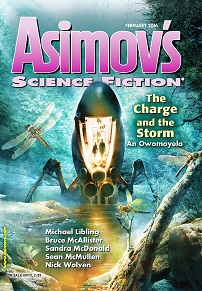 Asimov’s, February 2016
Asimov’s, February 2016
“The Grocer’s Wife [Enhanced Transcription]” by Michael Libling
Reviewed by Robert L Turner III
Michael Libling, with his “The Grocer’s Wife [Enhanced Transcription],” puts together two common fears, government surveillance and mental deterioration into a tightly written story. Andy, a government worker, must oversee the gradual progression of an old man’s Alzheimer’s. His subsequent moral quandary resolves in a logical, but surprising way. The story is well worth the read.
In “Bringing Them Back” Bruce McAllister uses a childhood habit of drawing and describing animals to tell an apocalyptic tale. The brief story is poignant and the pace is measured and the motion from impersonal to personal is excellent.
Sarah Gallien’s “In Equity” is set in a near future where the gap between the haves and have nots is now literal as well as financial. Cole is a foster child, now thirteen years old who has to go through the process of meeting with a potential foster family. As the story progresses, we learn why he was chosen and the consequences of his choice of whether to stay or not. The writing in the story is solid and the world building as well. However, the story fails to gel. There are dystopian elements, questions of personality and interpersonal relations, as well as hints of moral questions, but they fail to unify. While a decent read, the story lacks closure.
“Passion Summer” by Nick Wolven starts out with the question, what would happen if teenagers could choose what to be passionate about? He then uses the concept to explore what happens when a young man picks an unusual Passion. The reveal of what Passion Cole chooses is less important than the interpersonal dynamics of the various characters. Overall, Woven provides a very readable story.
“Exceptional Forces” by Sean McMullen takes place the night before an academic conference when an astoundingly bright professor becomes the target of an assassination. When he blows the assassin’s cover they trade secrets before his inevitable death. The story is clever and fun although some of the professor’s observations seem more mind reading than Sherlock Holmes. Despite this minor quibble, McMullen gives us an interesting story with a solid SF tie in that justifies its inclusion in Asimov’s.
“The Monster of 1928” by Sandra McDonald is a slice of life story with the title referring to the Okeechobee hurricane of 1928, which killed ~2500 people, as well as the actual swamp monster from the story. The reader is presented with an oral history from a mixed race transgender man who details life in the everglades during the 1920’s. The magical realistic story details the confluence of an encounter with a monster named the Tulu and the previously mentioned hurricane. The entire story reads like an entry from the Library of Congress Oral History Project and the calm tone of the story reinforces the feel.
“The Charge and the Storm” by An Owomoyela describes a world in which the descendants of a human colony ship live together with the Su, an insectoid race who has damaged their home world’s ecology to the point that they must live in a protective colony. Petra, a Maker, who has the ability to manipulate energy and smart matter is forced to face her past love and the betrayal that destroyed her previous serenity when she becomes responsible for a former friends life.
The story uses the outside climate as a metaphor for Petra’s internal struggle and the conflict between factions of human society. The novelette is, at times, overly heavy on description and occasionally loses the narrative thread, but An Owomoyela creates an interesting world that makes the reader want to return and visit.
Robert Turner is a professor and long term SF reader.